Of all of the retro consoles ripe for transformation into a miniaturized all-in-one device, NEC Home Electronics’ contribution to the world of gaming seemed like an incredibly unlikely choice to me. Known as the PC Engine in Japan, the system was quite popular in its home country back in the 16-bit era. However, here on our shores—and, really, around the rest of the world—the reputation of the renamed Turbografx-16 (or CoreGrafx in Europe) typically ranged from a strange curiosity to a non-contender, depending on who you spoke to. With NEC long gone from the console market, and the system’s designer and main software supporter Hudson Soft shut down back in 2012 and absorbed into Konami, I just never figured there’d be anyone out there to even contemplate making such a device.
The thing is, out of all of the consoles to bring back in “classic” form, I think the Turbografx-16 is possibly the most deserving. While the Super Nintendo and Sega Genesis were far more popular, there are numerous ways to buy games from those consoles digitally across a wide variety of platforms. As well, quality after-market options such as Analogue’s Super Nt and Mega Sg exist for those who no longer own or can’t afford original hardware. When it comes to affordability problems, the Turbo market has shot up in price for both hardware and software to ridiculous levels, now only second to SNK’s NeoGeo in some circumstances. And, outside of Nintendo’s once-great Virtual Console back on the Wii, and a smattering of releases on the PS3, the TG-16’s library hasn’t been available digitally in any legal way.
After a last-minute delay, we’re finally on the eve of the Turbografx-16 Mini’s release—and here are my thoughts after spending some time with the system.
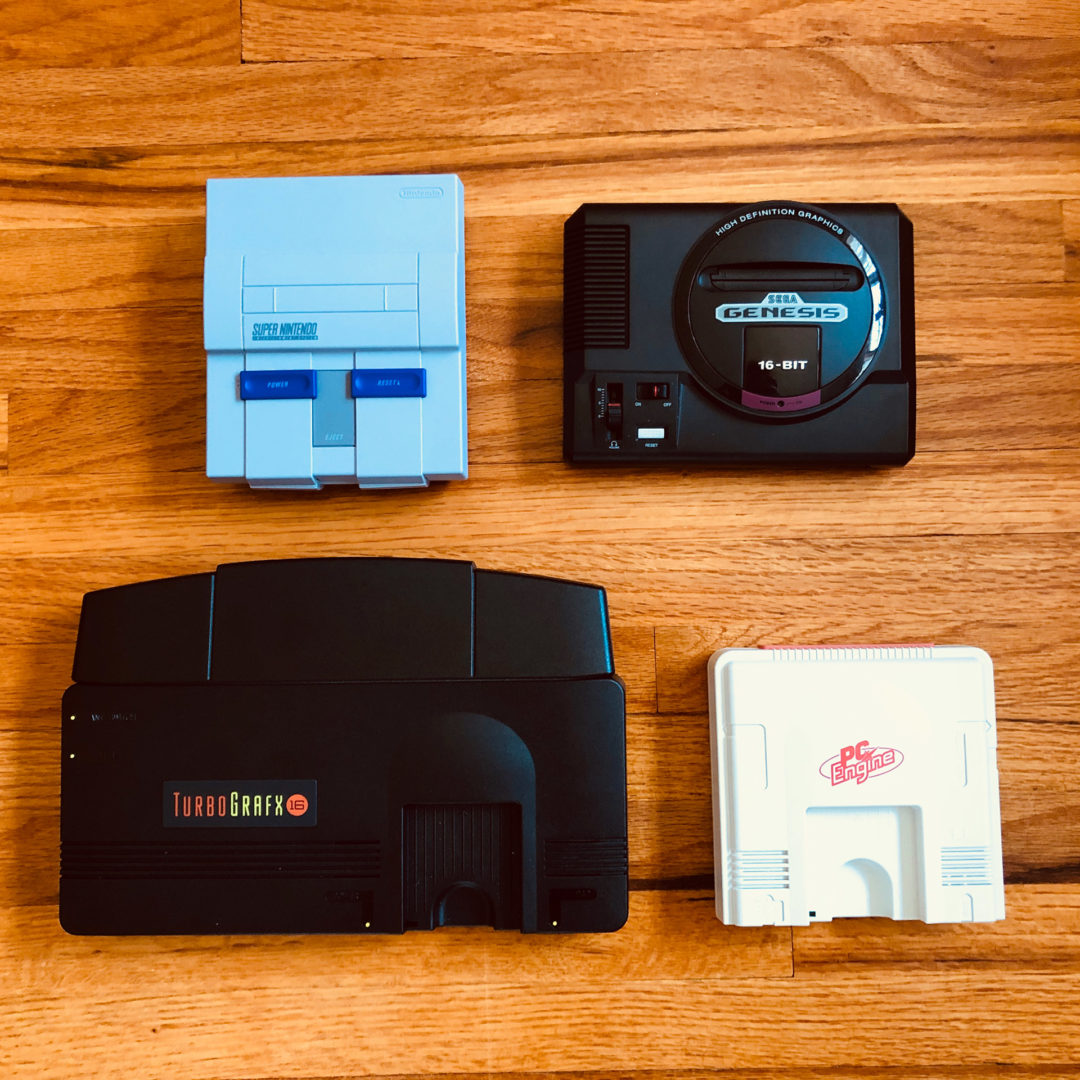
Hardware
The original Turbografx-16 was notorious for taking the PC Engine—the smallest proper console to ever see release—and turning it into a hulking monstrosity of unbridled Americana. Still, as ugly and bulky as the system was, there was also something lovable about it, which I’m reminded of when looking at this shrunken-down replica. The Turbografx-16 Mini does a great job of capturing all of the physical details from the original, even down to the extended expansion port on the back of the system that you can hide with a snap-on plastic cover.
One aspect Konami thankfully didn’t keep was having the system feature only one controller port. Instead, here we get two USB ports, meaning that a lot of multiplayer games are now playable without the need of a separate 5-player TurboTap (which, coincidentally, Hori is making a version of for these Mini consoles). Really, the only physical downside for me is that Konami didn’t take a page from the Genesis Mini and offer the option to slot replica game cartridges into the system. Given how iconic the TG-16’s credit card-sized HuCards were, it would have been a neat—but unnecessary—bonus.
The Turbografx-16 Mini comes with one replica TurboPad controller crafted to emulate the size and design of the originals. Now, it’s been a long time since I’ve used a proper TurboPad, but from memory, these feel pretty darn close. An added bonus we get over the Japanese release is a pack-in controller with turbo switches. Due to what I assume is a sense of tradition, the PC Engine Mini’s controller is devoid of those trademark switches, as they weren’t part of the initial controller design. Since the TG-16 came with controllers that supported varying levels of rapid fire from the start, we get those switches here too, and you’ll certainly enjoy having them when playing some of the included games. Oh, and special mention goes out to the controller’s 9-foot cable, which dwarfs both that of the original controller and other mini systems.
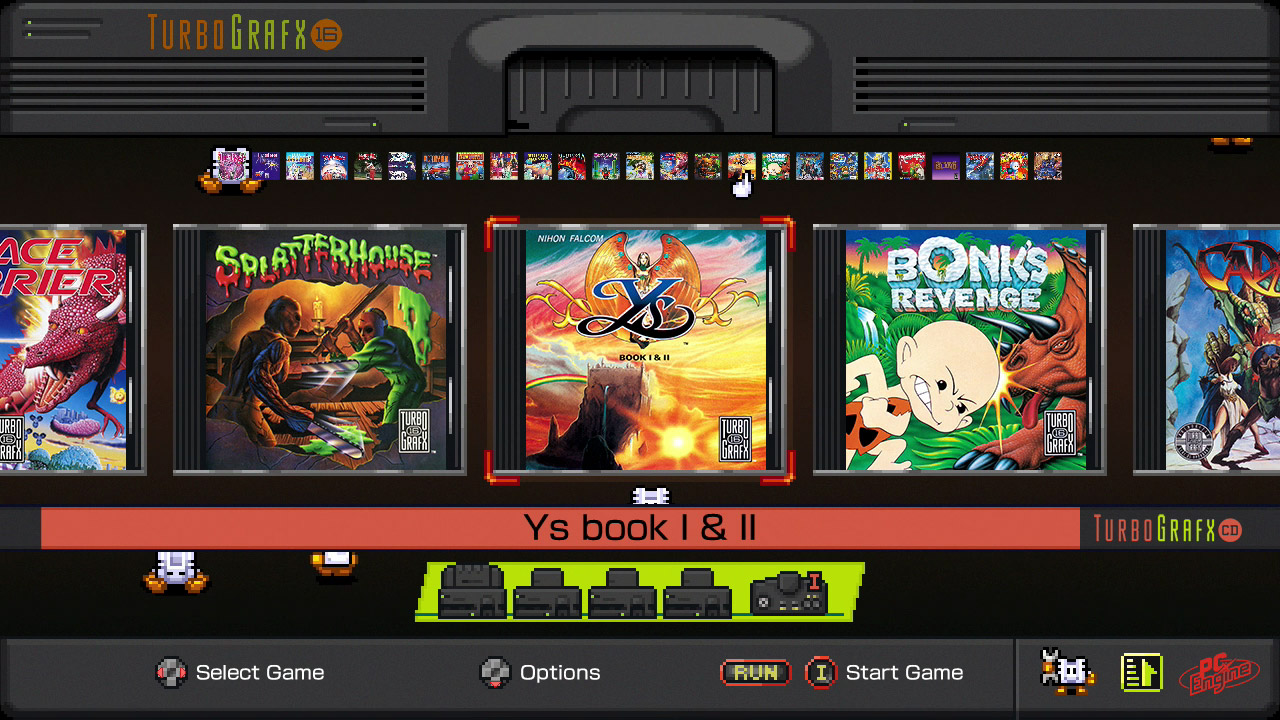
Presentation
We’ve seen a mix of good and not-so-good user interfaces for classic consoles so far, but I might argue that none have been better than what the Turbografx-16 Mini sports. Developer M2 has put a lot of work into crafting a main menu that offers both functionality and fanservice, and it’s almost an overload of nostalgia for those like me who loved the platform back in the day. Cover art is beautifully presented, and it’s even accompanied by recreations of each game’s case spine. The entire interface rethemes itself depending on if you’re browsing the American or Japanese game lists (more on that in a moment), and the entire time, little anthropomorphized PC Engines walk around the screen doing cute things. (Though, you can always turn them off if you’re heartless.)
The absolute best part of the interface is also its most functionally pointless: the special animations that happen when you start up a game. If you pick a standard game, a sprite version of the HuCard appears, and slides itself into the cartridge slot on the top of the screen. Meanwhile, if you pick a CD-based game, a virtual TurboCD unit pops up, complete with the initial CD OS boot screen and disc loading sound. The noise of the disc drive seeking data from a CD is burned into my brain to this day, and including it here serves no practical purpose, yet adds so much on an emotional level.
Settings-wise, the Turbografx-16 Mini supports six different languages, four choices of wallpaper, an option for either PC Engine or CoreGrafx UI elements when browsing Japanese games, and a small selection of display settings. Without getting too technical, there are five options: two for emulating the 4:3 screen size you would have seen when playing games on older televisions, a “pixel perfect” mode that displays pixels perfectly square (but not authentic to how they were originally presented), one for stretching games to the full height and width of modern day HDTVs (don’t even think about it), and a curious final option that makes it look like you’re playing games on the Turbografx-16’s portable variant, the TurboExpress. I can’t help but love that final choice, but really, it’s not something you’ll ever use beyond the occasional bout of curiosity.
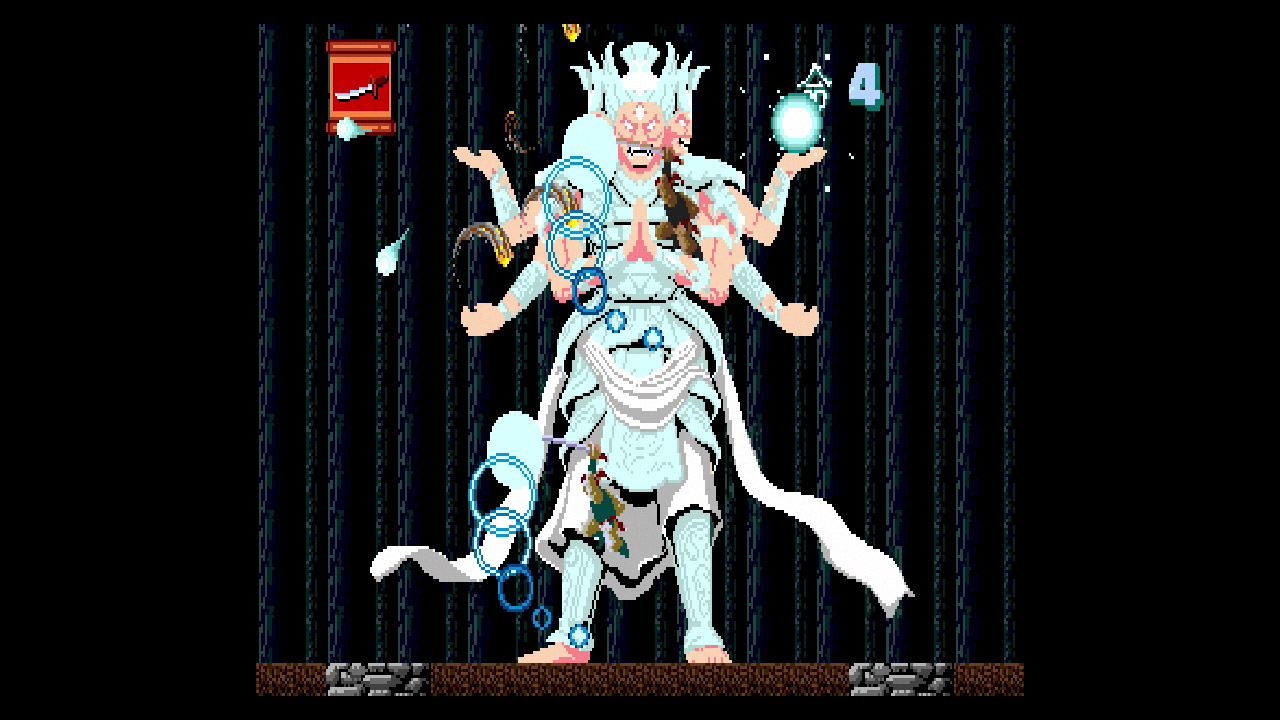
Software
Finally, we’re ready to talk about the games—but before we do, here’s a refresher on the Turbografx-16 Mini’s library:
Turbografx-16 Games
- Air Zonk
- Alien Crush
- Blazing Lazers
- Bomberman ‘93
- Bonk’s Revenge
- Cadash
- Chew-Man-Fu
- Dungeon Explorer
- J.J. & Jeff
- Lords Of Thunder
- Military Madness
- Moto Roader
- Neutopia
- Neutopia II
- New Adventure Island
- Ninja Spirit
- Parasol Stars
- Power Golf
- Psychosis
- R-Type
- Soldier Blade
- Space Harrier
- Splatterhouse
- Victory Run
- Ys Book I & II
PC-Engine Games
- Akumajou Dracula X Chi No Rondo
- Aldynes
- Appare! Gateball
- Bomberman ’94
- Bomberman Panic Bomber
- Chō Aniki
- Daimakaimura
- Dragon Spirit
- Dungeon Explorer
- Fantasy Zone
- Galaga ’88
- Ginga Fukei Densetsu Sapphire
- Gradius
- Gradius II – Gofer No Yabou –
- Jaseiken Necromancer
- Nectaris
- Neutopia
- Neutopia II
- Ninja Ryūkenden
- PC Genjin
- Salamander
- Seirei Senshi Spriggan
- Snatcher
- Spriggan Mark 2
- Star Parodier
- Super Darius
- Super Momotarou Dentetsu II
- Super Star Soldier
- The Genji and the Heike Clans
- The Kung Fu
- The Legend of Valkyrie
- Ys I & II
The list of included games is almost the same no matter which region of hardware you buy—PC Engine Mini–only titles Tokimeki Memorial and Tengai Makyou II: Manji Maru are swapped for Gradius spin-off Salamander (aka Life Force) on our Mini—and there have been some mixed opinions on that choice. On one hand, it can feel weird swapping back and forth between two separate lists of games, and titles like Ys Book I & II, Neutopia, and Dungeon Explorer show up on both sides, which you might argue is a waste of slots. Also, as awesome as it is to have Japan-only releases like Super Momotarou Dentetsu II and Jaseiken Necromancer, they’re totally useless to anyone without proficiency in reading and understanding Japanese. That is especially frustrating in the case of Snatcher, as it feels like a cruel tease to give it to us untranslated. The English-language Sega CD release is now ridiculously expensive, and I really hoped that Konami would surprise us with a fully localized version of the game, but alas.
The other side of the argument is that I don’t know that Konami could have done anything but fill the Turbografx-16 Mini with titles from multiple regions—at least, for those of us here in the West. Far too many of the PC Engine’s trademark titles never left Japan, and relying on only North American-released games would have left the system’s library feeling horribly anemic. The trade-off to having a handful of repeats and foreigner-unfriendly inclusions is a selection of titles that’s far stronger in the end. There are a lot of great Japanese games on here, from beloved classics like Dracula X (still one of the best Castlevanias ever released), to major franchise titles we never got like Bomberman ‘94 or the PC Engine version of Ninja Gaiden, to cult classics like Cho Aniki and Seirei Senshi Spriggan.
What most surprised me about the lineup is that, from there, Konami made a few choices that would end up hugely impacting how important the Turbografx-16 Mini is. There are a handful of titles on here whose physical copies are unobtainable for a majority of gamers, such as the fantastic shooter Ginga Fukei Densetsu Sapphire, which now often sells for $900 or more. Konami has even given us the two most important releases from the SuperGrafx, an ill-fated follow-up to the PC Engine that only sold around 75,000 units, and which received a scant five games. I’ve wanted to play its version of Daimakaimura (Ghouls ‘n Ghosts) since I first saw screenshots of it in the pages of EGM as a child, but there’s never been a real way for me—or nearly anybody—to play it or Aldynes outside of downloading ROMs.
For all of those reasons, and more, I can easily say that this is the best line-up of games a classic all-in-one console has ever featured when looking at the bigger picture. There were so many ways that the Turbografx-16 Mini could have gone wrong in terms of its library, but the choices Konami made were shockingly smart. Not perfect, mind you—there are a few obvious omissions here, such as the infamous North American pack-in Keith Courage in Alpha Zones, staples like Gates of Thunder and The Legendary Axe, or other out-of-reach releases like Magical Chase. Plus, there are a few of my personal favorites missing, such as Silent Debuggers and World Court Tennis (with its wonderfully bizarre tennis-based RPG mode). Still, it’s hard to complain given everything that we did get.
Although, there’s one thing that I really need to stress: This is a fabulous library of games for those who can appreciate it. Unlike the far more casual-friendly Sega Genesis and Super Nintendo, the Turbografx-16 was known in its time for playing host to an eclectic selection of games—many of which can now feel like bizarre relics of a bygone era. I’m genuinely excited by the idea of people who have never experienced the TG-16 now getting the chance to do so, but I’m also keenly aware that it’s absolutely not going to be for everyone.
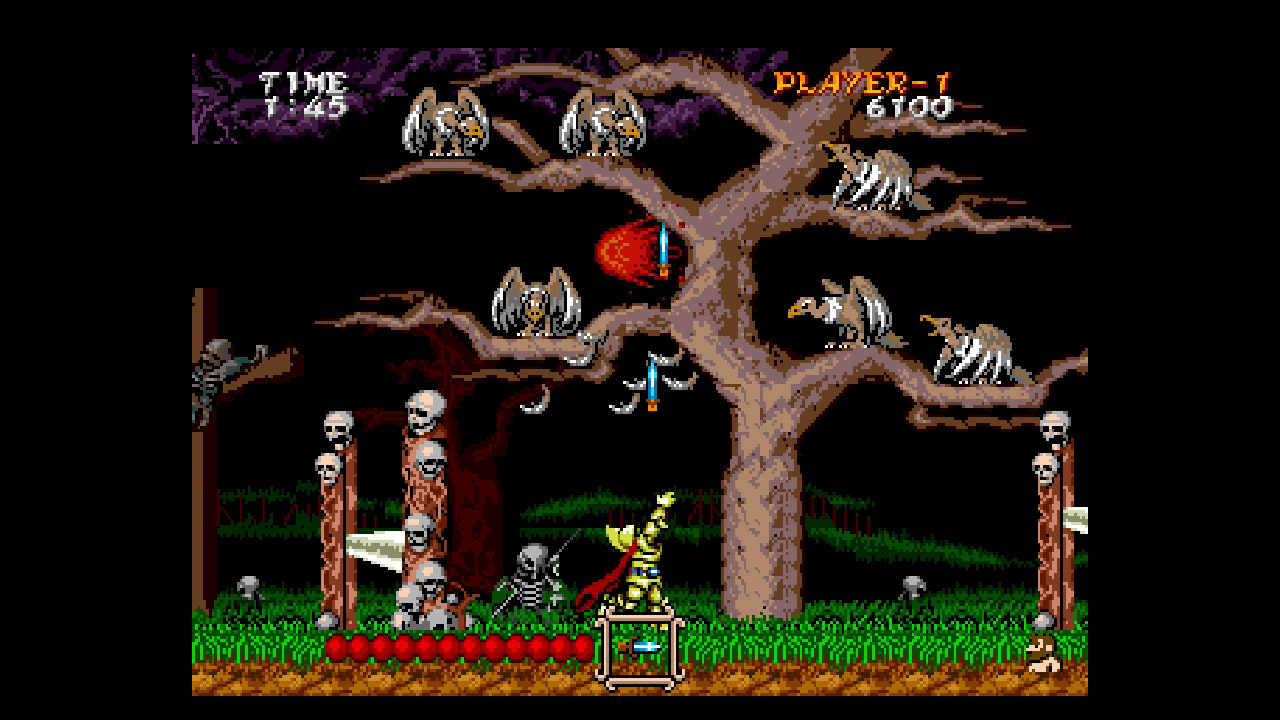
Emulation
When Konami finally revealed that retro specialists M2 would be handling the software side of the Turbografx-16 Mini, I was incredibly relieved. If there was anyone who could give the system and its games the proper care that they deserve, it’s M2, and the studio’s work here is mostly up to the standards it’s known for.
I say mostly because, much like M2’s work on the Genesis Mini, the software emulation here is just far enough away from being spot on to be slightly disappointing.
Here at EGM, we try very hard not to read reviews or other sources of opinion for things we ourselves are reviewing, lest they influence our own opinions either consciously or subconsciously. Well, I’m going to be honest here: Between purchasing the Japanese PC Engine Mini on my own, and the delay of its Western release, it was hard to avoid talk of the system until my review unit arrived.
The three main issues people have brought up are the existence of some amount of input lag, some amount of audio lag, and a visual “shimmering” effect that can occur at times due to the way M2’s emulation upscales pixels. So, rather than pretend that I didn’t know about those common complaints going into this review, I’ll tell you how my experience has been as someone who hasn’t touched the original hardware or games in about 15 years.
I can definitely confirm that there’s a slight shimmer that occurs as certain background elements scroll by, most notable for me in games like R-Type, Ninja Gaiden, and J.J. & Jeff. Really, though, it was never something that tainted my experience when playing, as I found it easy to ignore depending on the game. When it came to the input and audio lag, while I could find examples of them if I paid attention to doing so, for a majority of the time they were honestly a non-issue. Especially for a console so heavily focused around old-school shooters, I was nervous about the potential for lag going in, but Lords of Thunder was the only game where I truly felt like gameplay was negatively impacted. (And to be fair, I’d never played the game before now, so that might just be how it is.)
Otherwise, while I don’t want to downplay the fact that emulation issues do exist, if you don’t have an original Turbografx-16 to compare the Mini to, I think that lag is going to be hard to notice for many. I’d say the same for audio lag as well. Beyond a few games like Bonk’s Adventure where it did seem more noticeable when I focused on the timing of sound effect, I just don’t think most people are going to pick up on slight audio delays when their attention is on actually playing a game instead of analyzing it.
Do I wish there were no emulation issues of any kind to speak of? Of course I do. However, as this is a $99 mass market item based fully on software emulation, and not a more serious collector-focused piece of tech running FPGA-powered hardware emulation, I’m willing to cut the Turbografx-16 Mini a bit of slack (as I do all similar devices). Even with those issues, I still think this is a very respectable effort when compared to some of the other options out there, and firmly believe that most people will never even notice any of these hiccups.
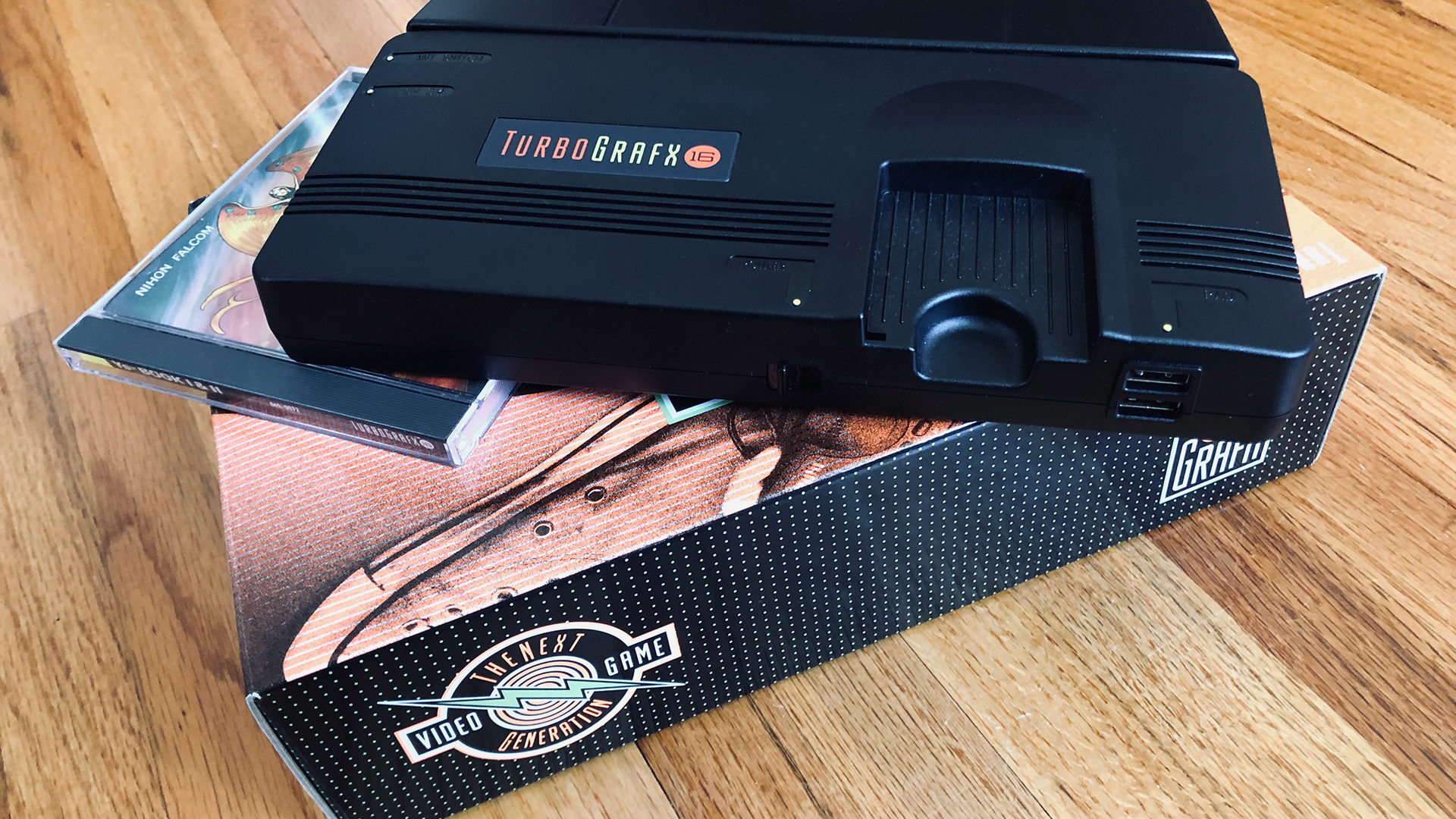
In closing
The Turbografx-16 Mini is unquestionably one of the most exciting all-in-one classic consoles that I’ve seen hit the market due to the work that’s gone into it, the stellar selection of games it features, the easy access it provides to a platform that’s often inaccessible, and the amount of money it can help save someone trying to build up a respectable Turbo library. This is in no way a product I could recommend to the everyone given how weird and unfamiliar the included games are, but for anyone who has ever pondered owning a Turbografx-16, or who is trying to replace a collection they once had (like me), the Turbografx-16 Mini is a great solution.
|
★★★★★
I still cannot believe that in the year 2020, Konami has not only decided to give us a new all-in-one system based around the legendary (and underappreciated) Turbografx-16, but that said project actually turned out as good as it did. Despite a few minor shortcomings that won’t affect most players, the Turbografx-16 Mini is easily one of the best classic consoles released up until this point—at least for people in the know enough to care. |
Developer M2 Publisher Konami ESRB M - Mature Release Date TBD |
| Turbografx-16 Mini is available on . Primary version played was for . Product was provided by Konami for the benefit of this coverage. EGM reviews on a scale of one to five stars. | |

Mollie got her start in games media via the crazy world of gaming fanzines, and now works at EGM with the goal of covering all of the weird Japanese and niche releases that nobody else on staff cares about. She’s active in the gaming community on a personal level, and an outspoken voice on topics such as equality in gaming, consumer rights, and good UI. Check her out on Bluesky and Mastodon.